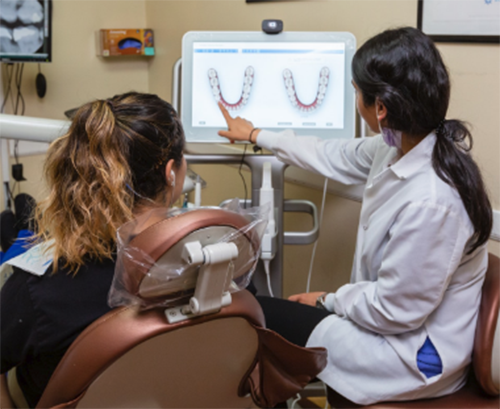Aftercare
Home >> Aftercare
New Filling – What To Expect?
Now that your new filling or fillings have been placed there are a few directions you need to follow.
First, be sure that the local anesthetic has completely worn off. This is to prevent you from biting or injuring your lip, cheeks or tongue. Also, refrain from drinking anything hot in temperature or smoking to prevent burning. Sometimes patients also find it difficult to swallow while still they are still numb, so please be careful. Our office only places tooth colored resin type fillings. These fillings are completly hardened when you leave the office. You can eat on them as soon as the numbness wears off. Although the fillings are polished before you leave, they may feel slightly gritty at first. This should go away after a couple of days. If not please call back.

Immediate post operative cold sensitivity is also possible!
This is usually from a normal reaction of the nerve following the procedure. Give it a couple of days and try a sensitivity protection toothpaste (i.e. Sensodyne or Crest for Sensitivity) until it subsides. If it persist beyond a week or so or seems to worsen please call our office. Discontinue the use of any whitening toothpaste or other whitening products until the sensitivity subsides Finally, if your bite seems off or if you cannot bite normally please call the office to have your filling adjusted. Do not wait for it to wear down on its own as the tooth may become tender.
Your new filling does require common sense care. Avoid excessive biting pressure on the teeth. Avoid chewing on ice, pencils, and hard objects. Continue to brush and floss regularly.
– Be sure your toothpaste contains fluoride. New filings are susceptible to developing new decay around the edges of the filling if not cared for.
– If you have experienced recurrent decay or have had multiple recurring cavities you may want to use a fluoride rinse like Act or other fluoride containing rinses. There are also prescription strength fluoride paste and gels that our office can recommend. Please ask at your next visit or call.
New Crown – What To Expect?
Upon leaving after the first visit, you will have a temporary dental crown on your tooth. A few precautions should be taken:.
Wait for anesthesia to wear off before eating or consuming hot items to avoid burning or biting yourself. Oraverse (reversal agent) would prevent this for future reference.
If the bite feels ‘high’ or the temp is hitting first when your teeth come together please return to have the bite adjusted as soon as possible. Failure to do so can result in a sore tooth or damaged temp.
Avoid sticky or chewy foods (e.g. chewing gum and caramels), which have the potential of grabbing and pulling at the crown.
Shift the bulk of your chewing to the opposite side of your mouth.
Avoid chewing hard foods (e.g. raw vegetables), which can dislodge or break the crown.
When cleaning your teeth, slide flossing material out, rather that lifting it out. Lifting the floss out could pull off the temporary crown.
Tooth may be sensitive at first, but if nerve is healthy it will settle down by insertion visit. In some cases if the old filling or decay was very deep the tooth may require further treatment (root canal) if the sensitivity doesn’t resolve.
Injection sites may be sore after numbness wears off. Give it a few days.
Root Canal – What To Expect?
First of all, congratulations, you made it through the root canal! Hopefully you had a pleasant experience, considering the circumstances. That truly is our goal. This sheet will go over some information about what to expect for the next few weeks now that the root canal is completed. Please follow the instructions outlined below, and contact us should any questions or problems arise.
- DO NOT eat or drink anything for the next half hour. DO NOT try to feel around your tooth with your tongue. You have a temporary filling in the tooth and it takes about half an hour to harden.
- You need to have a permanent filling or a crown placed on your tooth within 1 MONTH of the root canal being completed. If this is not done, the tooth is very likely to fracture or to develop new decay underneath the temporary filling which may cause your root canal to fail. DO NOT use the tooth to bite down on anything hard (peanuts, pretzels, ice, etc.) until the permanent filling/crown has been placed on the tooth. Again, the tooth is prone to fracture and if you bite down on anything too hard or crunchy you may crack the tooth.
- It is normal for the temporary filling to “divot” in with use. It is very rare for it to fall out entirely. If the temporary falls out you should contact us as soon as possible. If it happens when our office is closed, we recommend you purchase some temporary filling material from any pharmacy and place a dab in the tooth until you have an opportunity to see us at our office.
- Some minor discomfort in the area is normal following the root canal. It is normal for the tooth to be uncomfortable for 2-3 days after today’s treatment. Sometimes, depending on the circumstances, the tooth and surrounding tissues may remain sore for a few weeks post treatment. The three most common reasons for pain are:
– Sore jaw joint from having your mouth open for a prolonged time.
– Sore muscle from the injection site.
Sore gum from the rubber dam placement. - WHAT DO I DO ABOUT THE PAIN??? All of the above scenarios should be handled with over the counter medication, primarily. We recommend you take: 600 mg Ibuprofen (3 over the counter pills of Advil or Motrin or generic equivalent) every 6 hours for the next 2 days. OR (if unable to take ibuprofen) 1000mg Acetaminophen (2 extra strength Tylenol or generic equivalent) every 6-8 hours for the next 2 days. 90% of the time this is enough to handle the discomfort. If it is not, please contact our office and we will ensure you are comfortable.
- If you are given any prescription medications related to this treatment please take them as instructed by your doctor.
- You may floss and brush your tooth as normal, unless told otherwise by the doctor
- PLEASE READ THIS LAST SECTION, IT IS VERY IMPORTANT!!!! FLARE-UPSAlthough about 95% of root canals cause very little to no discomfort after the treatment is completed, there are about 5% of cases which can cause significant pain. These are commonly referred to as “flare-ups.” They mostly occur on badly infected teeth, teeth that are extremely irritated, or teeth that have a history of prior treatment. Sometimes, however, they occur randomly, even on patients that have had several root canals done previously without any problems. If you have a flare-up you may experience moderate to severe pain, swelling (can get as large as a golf ball), bruising, throbbing, and general discomfort, which usually begins a few hours after treatment and may last 2 to 3 days.
- Please contact our office if you experience any of these symptoms and we will do everything we possibly can to get you some relief. You may be prescribed antibiotics, stronger pain medication, a steroid, and/or you may be asked to come to the office to receive further therapy. Thank you.
Post Operative Instructions for Scaling and Root Planing What to Expect?
Most patients experience little or no discomfort after scaling and root planing. The most frequent complaints are: slight tenderness of the gum tissue, teeth that are mildly sensitive to cold drinks and foods, and discomfort when eating spicy foods. You may do the following to minimize any of these inconveniences:
Avoid eating spicy foods for several days.
Take an over-the-counter analagesic such as Advil or Alleve® before your local anesthesia wears off. Later, you can take the same medication if you have any tenderness of the gums. If you must avoid these analgesics because you are already taking NSAID’s, are allergic to them, or you have ulcers, then you may take acetaminophen (Tylenol®). Please follow dosage recommendations on the product labels.
After the blood clot forms, it’s important to protect it, especially for the next 24 hours. It’s important to NOT:
It is important to maintain good plaque control to promote optimal healing after scaling and root planing. Therefore, please perform all home care procedures as prescribed by your dentist or hygienist.
You may experience some discomfort when you drink cold liquids or eat cold foods. This sensitivity is the most common complaint after root planing and is due to removal of tartar and a minute amount of tooth root surface. Any sensitivity should gradually go away in a few weeks; however, in some cases, the sensitivity can take longer to go away. In rare cases, some permanent sensitivity results. Try to avoid really cold liquids and foods for a few days or more after the scaling and root planing is performed. If needed, you can use desensitizing toothpastes, such as Crest for Sensitive Teeth® or Sensodyne® to help reduce the sensitivity.
Please call the office if you experience any problems other than those listed above.
Root Canal – What To Expect?
After an extraction, it’s important for a blood clot to form to stop the bleeding and begin the healing process. That’s why your dentist will ask you to bite on a gauze pad for 30 to 45 minutes after an extraction. If bleeding or oozing continues after you remove the gauze pad, place another gauze pad on the area and bite firmly for another 30 minutes. You may have to do this several times.
After the blood clot forms, it’s important to protect it, especially for the next 24 hours. It’s important to NOT:
Limit yourself to calm activities for the first 24 hours. This keeps your blood pressure lower, reduces bleeding, and helps the healing process.
After the tooth is extracted, you may feel some pain and have some swelling. You can use an ice bag (20 minutes on, 20 minutes off) to keep this to a minimum. The swelling usually starts to go down after 48 hours.
To control discomfort, take pain medication as recommended. Don’t take medication on an empty stomach or nausea may result. If antibiotics are prescribed, continue to take them for the indicated length of time, even if all symptoms and signs of infection are gone. Also:
- Smoke
- Suck through a straw
- Rinse your mouth vigorously
- clean the teeth next to the extraction site
- Drink lots of fluids.
- Eat only soft, nutritious foods on the day of the extraction.
- RDon’t use alcoholic beverages.
- Avoid hot and spicy foods.













